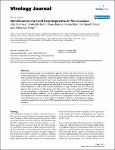Identification of a novel betaherpesvirus in Mus musculus
Teterina, Alla
Richter, Dania
Matuschka, Franz-Rainer
Ehlers, Bernhard
Voigt, Sebastian
Rodent betaherpesviruses vary considerably in genomic content, and these variations can result in a distinct pathogenicity. Therefore, the identification of unknown betaherpesviruses in house mice (Mus musculus), the most important rodent host species in basic research, is of importance. During a search for novel herpesviruses in house mice using herpesvirus consensus PCR and attempts to isolate viruses in tissue culture, we identified a previously unknown betaherpesvirus. The primary PCR search in mouse organs revealed the presence of known strains of murine cytomegalovirus (Murid herpesvirus 1) and of Mus musculus rhadinovirus 1 only. However, the novel virus was detected after incubation of organ pieces in fibroblast tissue culture and subsequent PCR analysis of the supernatants. Long-distance PCR amplification including the DNA polymerase and glycoprotein B genes revealed a 3.4 kb sequence that was similar to sequences of rodent cytomegaloviruses. Pairwise sequence comparisons and phylogenetic analyses showed that this newly identified murine virus is most similar to the English isolate of rat cytomegalovirus, thereby raising the possibility that two distinct CMV lineages have evolved in both Mus musculus and Rattus norvegicus.
Dateien zu dieser Publikation
Keine Lizenzangabe
Verwandte Publikationen
Anzeige der Publikationen mit ähnlichem Titel, Autor, Urheber und Thema.
-
2007-05-25ZeitschriftenartikelFepA- and TonB-dependent bacteriophage H8: receptor binding and genomic sequence. Rabsch, Wolfgang; Ma, Li; Wiley, Graham; Najar, Fares Z.; Kaserer, Wallace; Schuerch, Daniel W.; Klebba, Joseph E.; Roe, Bruce A.; Gomez, Jenny A. Laverde; Schallmey, Marcus; Newton, Salete M. C.; Klebba, Phillip E.H8 is derived from a collection of Salmonella enterica serotype Enteritidis bacteriophage. Its morphology and genomic structure closely resemble those of bacteriophage T5 in the family Siphoviridae. H8 infected S. enterica ...
-
2005-06-20ZeitschriftenartikelViral promoters can initiate expression of toxin genes introduced into Escherichia coli Lewin, Astrid; Mayer, Martin; Chusainow, Janet; Jacob, Daniela; Appel, BerndBackground: The expression of recombinant proteins in eukaryotic cells requires the fusion of the coding region to a promoter functional in the eukaryotic cell line. Viral promoters are very often used for this purpose. ...
-
2013-08-08ZeitschriftenartikelCytomegalovirus Downregulates IRE1 to Repress the Unfolded Protein Response Stahl, Sebastian; Burkhart, Julia M.; Hinte, Florian; Tirosh, Boaz; Mohr, Hermine; Zahedi, René P.; Sickmann, Albert; Ruzsics, Zsolt; Budt, Matthias; Brune, WolframDuring viral infection, a massive demand for viral glycoproteins can overwhelm the capacity of the protein folding and quality control machinery, leading to an accumulation of unfolded proteins in the endoplasmic reticulum ...

